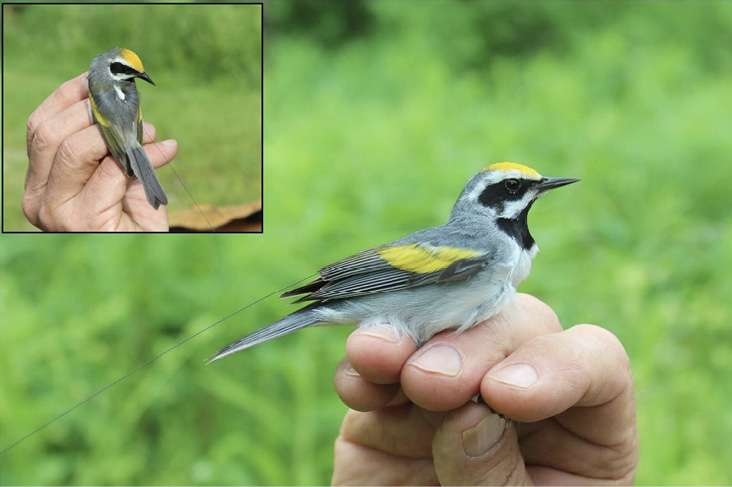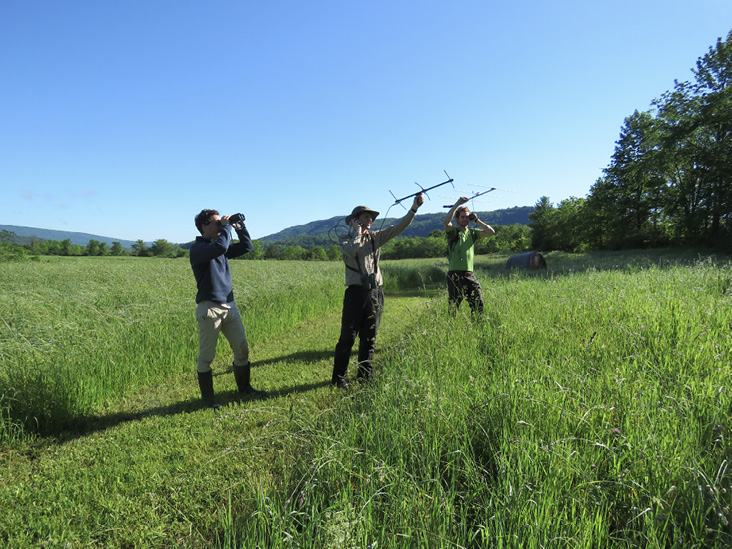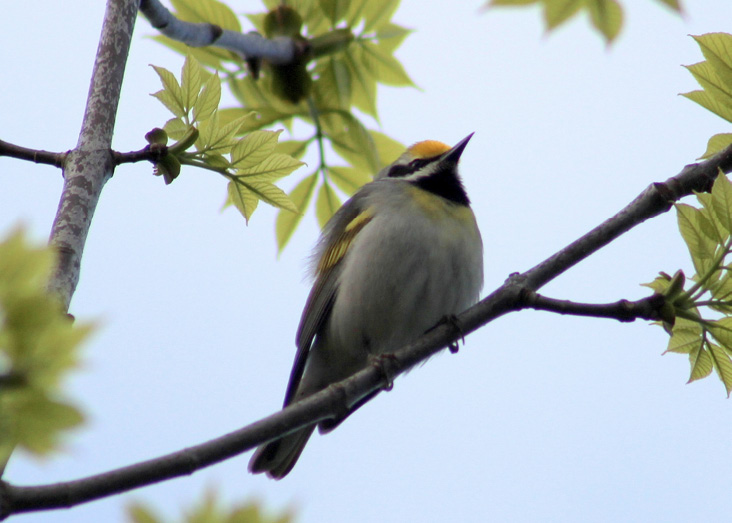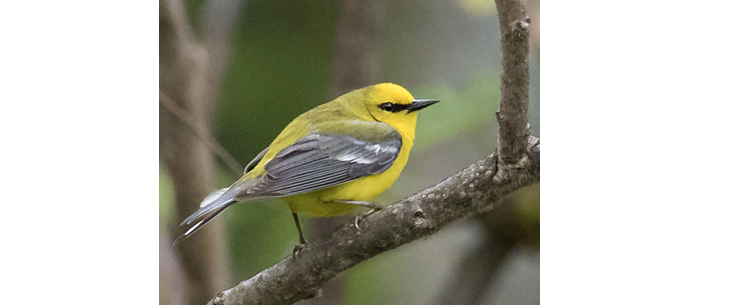Steven Lamonde and Mark LaBarr

A male Golden-winged Warbler sports a temporary, lightweight nanotag that sends out a coded radio signal. Photograph by Steven Lamonde.
Just a few decades ago, Golden-winged Warblers were thought to have disappeared from all of New England. Thanks to recent volunteer surveys and scientific studies over the past eight years by Audubon Vermont and partnering institutions, a modest population of Golden-winged Warblers has been documented in Vermont's Champlain Valley. This near-endangered species' geographic range forms two disjunct populations—one in the central highlands of the Appalachian Mountains and one surrounding the Great Lakes. Breeding Bird Survey data exhibit a 66% decline in Golden-winged Warbler populations, making it one of the fastest declining songbird species in North America. Its at-risk population status promotes the bird as a flagship species for conservation of early-successional forest habitat, the preferred habitat of Golden-winged Warblers and other cohabitating species of greatest conservation need in Vermont, such as Brown Thrasher, Field Sparrow, Prairie Warbler, and Eastern Towhee.
To better understand the habitat of Golden-winged Warblers, we completed a series of GIS analyses for Audubon Vermont from 2016 to 2019 that located patches of early-successional forest throughout Vermont's Champlain Valley. Just as the human brain can look at an aerial image and tell the difference between a building and a driveway or a grassy field and a forest, we trained a computer to identify the visual pattern of early-successional forest that Golden-winged Warblers prefer. Our goal was to find all the other places in the Champlain Valley that matched the same visual "fingerprint." After a few improving iterations, the analysis yielded approximately 10,000 acres of potentially suitable habitat spread across nearly 8,700 parcels, most of them privately owned. While 10,000 acres sounds like a lot, this area covers just 1.23% of the Champlain Valley—underscoring the general scarcity of early-successional forest in Vermont and across much of New England.

Half of radio telemetry research is putting a radio tag on the organisms; the other half is tracking each tagged individual. Here, Steven (center) and two field technicians listen closely for nanotag radio signals. Photograph by Mark LaBarr.
To gain permission for targeted winged-warbler surveys, we sent letters to 183 landowners who owned particularly good-looking habitat. These surveys turned up 49 winged-warblers: Golden-winged Warblers (29%), Blue-winged Warblers (42%), and hybrids or unseen winged-warblers (29%). Some preliminary calculations estimate that 192 Golden-winged Warbler pairs exist in Vermont, nearly 10 times more than previously thought in 2012. While this species is certainly not yet gone from New England, the ephemeral early-successional habitat that winged-warblers depend on needs to be actively managed and maintained, through either human or natural means. Without it, early-successional forest will mature into tall deciduous forests and the habitat will be better suited for Ovenbirds and Scarlet Tanagers than Golden-winged Warblers.
While working on our GIS analysis, we learned about a new study by researchers at Cornell Lab of Ornithology who found that Golden-winged Warblers and their close cousin, Blue-winged Warblers, were 99.97% genetically similar (Toews et al. 2016). To place this in perspective, two subspecies of Swainson's Thrush, olive-backed and russet-backed, have more genetic differences than Golden-winged and Blue-winged warblers. Similarly, other researchers have also compared a 0.03% genetic difference to humans with and without freckles. Furthermore, the genetic separation between Golden-winged and Blue-winged warblers manifests itself as different plumage characteristics—nothing more. Scientists have known for some time that these species hybridize, and that their offspring are fertile, or able to produce viable young. This raises the question: are Golden-winged Warblers and Blue-winged Warblers the same species despite looking markedly different.
Setting this question aside, especially when recognizing that Golden-winged and Blue-winged Warblers exhibit the same habitat preferences in Vermont, we adopted a more modern "conservation unit" approach to guide our work. Whether or not these two different-looking warblers are classified as the same species, our goal is to protect the entire Vermivora complex: Golden-winged Warblers, Blue-winged Warblers, and the many different hybrids that span a complex plumage spectrum from "pure" Golden-winged Warbler to "pure" Blue-winged Warbler. While robust genetic mixing between Golden-wings and Blue-wings can frustrate birders who are looking to add these species to their lists, the direct correlation of plumage pattern to genetic separation of Golden-winged Warblers and Blue-winged Warblers lends itself well to determining, to the best of a birder's ability, if a winged-warbler is a hybrid or pure. No one field mark can determine if a winged-warbler is a pure bird or hybrid, yet a combination of characteristics can.
| Golden-winged Warbler |
Brewster's Warbler (hybrid) |
Wing bar color: all yellow
Wing bar width: broad and confluent
Breast color: gray or white
Throat: black |
Wing bar color: gray, white, or faint yellow
Wing bar width: broad and partly separated
Breast color: gray or white
Throat: no black |
| Lawrence's Warbler (hybrid) |
Blue-winged Warbler |
Wing bar color: mixed white and yellow
Wing bar width: broad and partly separated
Breast color: all yellow
Throat color: black |
Wing bar color: all white
Wing bar width: narrow and well separated
Breast color: Yellow-green
Throat: no black |
Table 1. Comparison of key plumage characteristics to differentiate pure winged-warblers from hybrids. A full comparison of 11 characteristics can be found at https://vt.audubon.org/sites/default/files/static_pages/attachments/winged-warblers._how_to_tell_a_pure_species_from_a_hybrid._7-10-19e.pdf.
After working with Ian Worley and leaning heavily on the genetic work done by David Toews and others (2016), we produced a set of guidelines for identifying winged-warblers and entering them into eBird, the popular international citizen-science database for birds. Any bird that deviates from pure Golden-wing and Blue-wing characteristics (Table 1) should be entered into eBird using one of the following categories that best describes the plumage pattern: "Golden-winged x Blue-winged Warbler (hybrid)," Lawrence's Warbler (hybrid), Brewster's Warbler (hybrid), or the catch-all category "Golden-winged/Blue-winged Warbler." This last option is particularly useful in the hybrid zone of these two species when a winged-warbler is heard and not seen. In Vermont, winged-warblers can sing a variety of songs, ranging from the typical bee-bzzzz of the Blue-winged Warbler to a bee-bzzzz-bzzzz-bzzzz-bzzzz, one more bzzzz than a typical Golden-winged Warbler song. Preliminary data we collected in 2017 suggest that Golden-winged Warblers in Vermont are more likely to sing a typical Blue-winged Warbler song than Blue-winged Warblers are to sing a typical Golden-winged Warbler song. The reason behind this is unknown, although it may have to do with the gradual shift in Vermont's winged-warbler population from mostly Golden-winged Warblers to mostly Blue-winged Warblers.

This bird looks similar to a Golden-winged Warbler, but the yellow wash on the breast and wing bars indicate it possesses some Blue-winged Warbler DNA. Photograph by Steven Lamonde.
In early 2018, another groundbreaking study was published. To learn more about the migratory pathways of winged-warblers from both the Appalachian and Great Lakes populations, ornithologists tracked individual winged-warblers with lightweight geolocators (Kramer et al. 2018). Kramer and his team found that birds from these populations overwintered in separate places in the tropics, and where these birds overwintered directly correlated to population declines. Golden-winged Warblers from the rapidly declining Appalachian population overwinter in Venezuela, where deforestation is a major issue. Conversely, Golden-winged Warblers from the Great Lakes region, along with most Blue-winged Warblers and hybrids, overwinter in Central America, where deforestation is less of a problem. This study highlights the need for full life-cycle conservation, not just for Golden-winged Warblers, but for all migratory birds. Land conservation and habitat management for Golden-winged Warblers on their breeding grounds can improve reproductive success, and possibly decrease recovery and preparation time for spring and fall migration, respectively. However, without protection of the forests on Golden-winged Warbler's wintering grounds, the Appalachian population will likely continue to decline dramatically.
Between June and July of the 2019 breeding season, we conducted a radio telemetry study of winged-warblers by placing nanotag trackers on 13 adult male winged-warblers. The nanotags, weighing just 0.31 grams, or about one-seventh of a dime, emit a coded radio signal, which is unique to each individual tag (See Figure 1). Over a two-month period, we checked on each bird at different times of day to see where it was and what it was doing. While this data is still being analyzed, we learned that the habitat component of adjacent mature deciduous forest is more important than previously thought. Originally, Golden-winged Warbler researchers found that adult males will take half of their fledglings into the mature forest to forage prior to migrating south. Adult females, on the other hand, will take the other half of the brood and raise them in the early-successional, scrub/shrub part of their habitat. We found adult males actively using the mature forest canopy, sometimes farther than 300 meters from their nests. Although we had a hard time following adult males through the mature forest, where visibility into the canopy was low and the males would rarely vocalize, we could presume they were foraging because on return to the nest they often had a juicy caterpillar or other insect. Is it possible these males were also scouting out places to bring their young once they fledged? More research is needed.

Blue-winged Warbler. Photograph by Sandy Selesky.
Not only did this radio telemetry study yield interesting and informative behavioral patterns, we are also using the data combining each male's movements across the entire season to calculate its breeding home range, or the entire area an organism uses to defend a territory, attract a mate, forage, and raise young. Once a home range is calculated, we will look at the forest structure to quantify what percent of the home range comprises mature forest, early-successional forest, and herbaceous cover. Through the knowledge of how much each habitat ingredient is needed to make the ideal environment, we can improve current habitat management guidelines for winged-warblers in Vermont.
For the 2020 breeding season, Audubon Vermont will focus on surveys in the northern Champlain Valley to gain a better understanding of how winged-warblers are distributed across the entire Champlain Valley, ultimately allowing us to continue working to maintain the habitat that is important to support these songbirds.
Literature cited
- Kramer, G. R., D. E. Andersen, D. A. Buehler, P. B. Wood, S. M. Peterson, J. A. Lehman, K. R. Aldinger, L. P. Bulluck, S. Harding, J. A. Jones, J. P. Loegering, C. Smalling, R. Vallender, and H. M. Streby. 2018. Population trends in Vermivora warblers are linked to strong migratory connectivity, Proceedings of the National Academy of Sciences of the United States of America 114(14): 3192-3200.
- Toews, D.P.L., S.A. Taylor, R. Vallender, A. Brelsford, B.G. Butcher, P.W. Messer, and I.J. Lovette. 2016. Plumage genes and little else distinguish the genomes of hybridizing warblers, Current Biology 26(17): 2313-2318.
Steven Lamonde grew up in Massachusetts's South Shore area and has been a bird enthusiast from a young age. After discovering the world of birding from a Great Backyard Bird Count in college, hardly a day has gone by when he doesn't submit at least one eBird checklist. Steven is currently a postgraduate fellow in Antioch University New England's Department of Environmental Studies, where he teaches graduate courses in geographic information systems and manages the Antioch Spatial Analysis Lab. Since 2016, beginning with research for his master's degree, he has worked closely with Audubon Vermont on multiple Golden-winged Warbler conservation projects. In addition to teaching and research, Steven co-directs the Antioch Bird Club, a group based in Keene, New Hampshire, that organizes regional birding trips and educational walks and talks for community members.
Mark LaBarr is Conservation Biologist and Program Manager and oversees conservation projects, project staff, and volunteers for Audubon Vermont, including the Champlain Valley Bird Initiative. As a biologist, his focus is on the Common Tern Recovery Project as well as on efforts to better understand breeding populations of Golden-winged Warblers and other grassland and shrubland obligates in the Champlain Valley. He has a master birdbanding permit and runs the Audubon birdbanding station at the Green Mountain Audubon Center. He works in close cooperation with partner agencies and organizations such as the Vermont Fish and Wildlife Department, the Natural Resources Conservation Service, and the University of Vermont. He is the Chair of the Scientific Advisory Group on Birds for the Vermont Endangered and Threatened Species Committee, and he served on the Bird Technical Committee for the State's Wildlife Action Plan. He obtained his undergraduate degree in Wildlife Biology from the University of Vermont and a master's degree in Education from St. Michael's College.